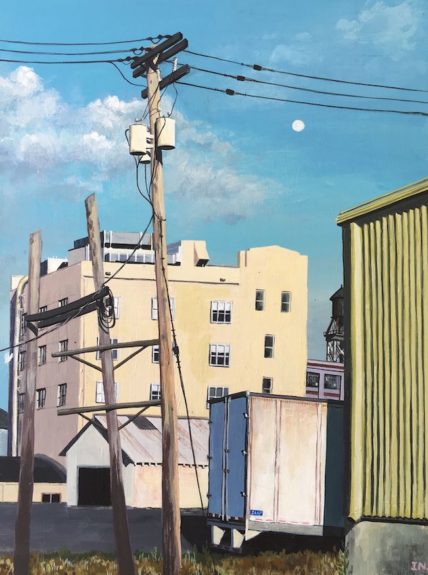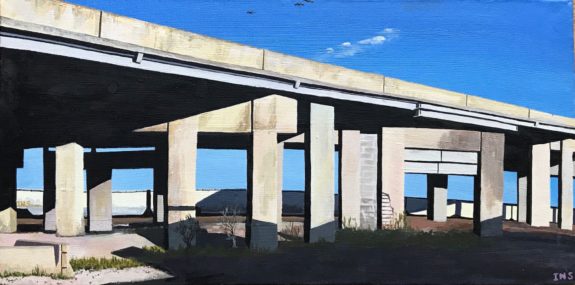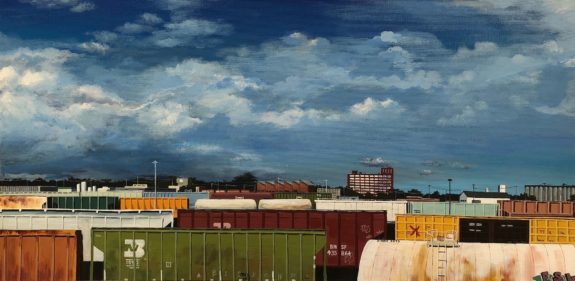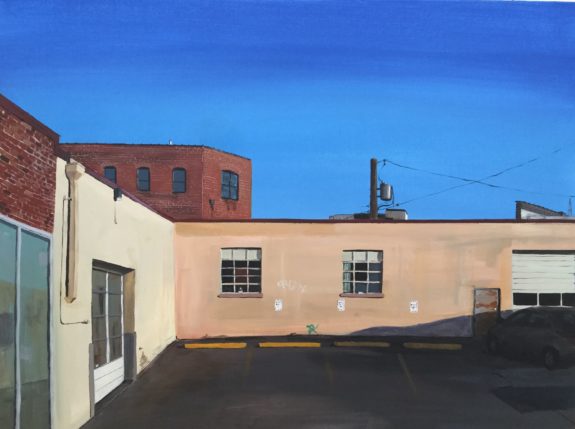Senior Staff Writer Ruby Mustill speaks with friend, master chef, and Precisionist painter Isobel Shaffer—the self-proclaimed Walmart Edward Hopper—about her art.
Bwog: Do you want to start by introducing yourself?
Isobel Shaffer: I’m Isobel Shaffer, I’m a senior in Columbia College, and I’m from Kansas City, Missouri. I’m an Urban Studies major, and in my free time, I spend a lot of time working as a painter. I paint urban landscapes and industrial scenes in a naturalistic style.

Isobel Shaffer, Day Moon over Kansas City, 2019
Why do you paint urban landscapes, and when did you start painting them?
I’ve been a bit aesthetically obsessed with the built environment for as long as I can remember and for reasons I don’t really understand. In high school, I discovered that I liked painting buildings when I took a painting class. My mother’s a painter, but she’s a portrait painter. I never really tried painting because, you know, you don’t want to follow in your parents’ footsteps. But then I did, and I haven’t stopped since high school.
You said you like buildings for reasons you don’t understand. How do you feel when you look at them?
Orgasmic [laughs]. No. I imagine it’s how people feel when they look at a sunset. I think there’s a political component to it now too. I care a lot about urbanism as a project and real estate and land rights, so that kind of ties in. But at the end of the day, it’s just a deep connection to the beauty of the spaces I like to paint.

Isobel Shaffer, White Overpass, 2019
A few years ago, you talked about not knowing what to say when people asked you what your paintings meant. But lately you’ve said you wanted to rewrite your artist statement. What’s changed?
I care about getting people to look at the built environment in a new way, or in a different way. I think we live these hyper-technologized lives, we spend a lot of time staring at screens and not looking at the world, and there’s a lot of value to be perceived in the built environment around us. I think it would make people appreciate and care more about the world around them if they paid more attention, and that’s what painting can do. It can force people to look at things with care that they wouldn’t have before.
What medium do you use?
I work with acrylics. I like them because they dry fast and they’re easier for doing detailing, I’d say. And if you’re trying to make clean lines, acrylics are better than oils. They’re also less toxic and easier to travel with. I do not paint en plein air. I take lots and lots of photos of the things I paint, and I work from those photographs.

Isobel Shaffer, Dawn in the Fairfax District, 2020
Your Instagram bio says you’re the Walmart Edward Hopper. Is he one of your influences, and who are the others?
Yes, Edward Hopper is my biggest influence. Or one of my biggest influences. Other painters like Charles Sheeler, George Ault, Ralston Crawford—the 1930s American school known as Precisionism, the closest thing America’s ever had to socialist realism. And then there are some contemporary painters I’m very inspired by: an Australian painter called Jeffrey Smart, who does incredible cityscapes that have a touch of surrealism to them. Rackstraw Downes is a British painter who does a lot of really cool American scenes, whom I’m a big fan of.
Do you have a favorite painting of yours?
Of mine? Yeah. It was one I did called Baltimore Avenue, that’s of the back of a building in Kansas City. That one I’m quite fond of. I don’t know why [laughs].

Isobel Shaffer, Baltimore Avenue, 2019
How do you think your work will evolve over time?
Hopefully it will just get better, more naturalistic. I’m trying to experiment a little bit with slightly more surrealistic and stylized images. Trying to bring in elements of color and arrangements of space that are just slightly off, you know? To give it that sort of David Lynch vibe. That’s where I’d like to go.
Do you want people to think or feel more when they look at your paintings?
Feel. No. Yeah, feel.
Why?
That’s a tough question. Because I can politicize or give rational descriptions of what I do. I can try to explain it in words, but at the end of the day it’s just an intense feeling on my part. And it’s an intense feeling that I would really like to share with other people to bond with them. But I never can in words or anything else, so my hope is always that, maybe with painting, I can get some people to feel what I feel.

Isobel Shaffer, One Car, Two Car, Red Car, Blue Car, 2019
A lot of your paintings are of Colorado or Kansas City. How does being in New York affect your work?
Negatively! [laughs]
Do you ever paint New York?
Occasionally. Right now I’ve just been doing a study of a building on campus, one of the many Brutalist buildings around here. But New York doesn’t inspire me as much because it’s too appreciated, I think. People understand that New York is a beautiful city. It doesn’t need my help.

Isobel Shaffer, Crossroads Parking Lot, 2017
You can view more of Isobel’s work on Instagram and Pinterest. This interview has been edited for length and clarity.
Featured Image: Isobel Shaffer, Calcite Factory: Arches, 2018
Paintings courtesy of Isobel Shaffer


 3 Comments
3 Comments
3 Comments
@Anonymous I love bwog and its writers.
@Anonymous Wow! This interview packs a lot of perspective in a few words. Thank you both for doing.
@Anonymous isobel is the coolest person i’ve ever met